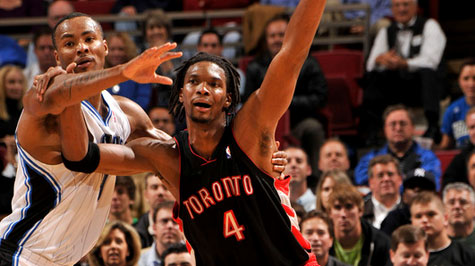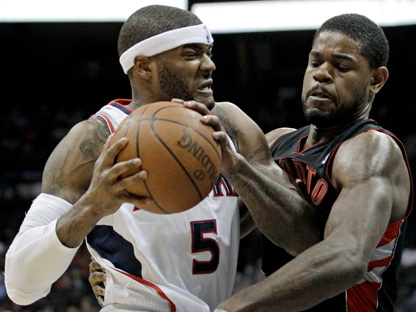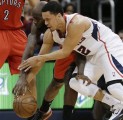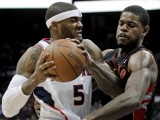 Ask for the ball like you mean it.
Ask for the ball like you mean it.The post-up game is a dying thing with the game becoming more and more perimeter-oriented as making the jumper becomes sexier by the day. I blame Kevin Garnett because he started this movement of 7-footers relying on their perimeter game while being applauded for it. They thought it was the great skill, a tall guy dribbling the ball and pulling back for a jumper. I remember Garnett in an interview pointing out Marcus Camby as a type of player that could revolutionize the game by bringing the ball up the court and playing like a guard. I also remember thinking to myself then, why the hell would he want to play like a guard when he’s built like a center? It was the year 1995 – it was the best of times, it was the worst of times. More than a decade later you now have to think hard before coming up with a list of good post-up players, those who you feel comfortable dumping the ball down-low knowing they’ll do something manly with it.
Everybody loves movement and one of the factors that determines how much movement there will be in an offense is the incentive to move without the ball. An offense based around a simple high-screen often results in a two-man game with three men standing around waiting for the action to happen. A double-team resulting from a post-up encourages many types of off-the-ball movement, I’ll point to two of my favorite ones. First it’s “the cutter” whose man is helping from the strong side with the double (shortest path to double) leaving him free to cut to the rim which in turns forces the defense to react by starting their rotation, usually collapsing. If the pass is made to the cutter, it inevitably leaves a perimeter player wide open as making a paint and a perimeter rotation is tough. If the defense is late to react to the cutter it ends up being a good situation for the offense as a foul, hoop or challenge is usually the result.
Secondly, there’s the weak-side help which involves the defense sending a man from the corner or wing (usually the corner) to help out, the defense is hoping that even if the ball-handler spots the open man, the pass is too risky to make. Usually at least one swing pass is needed to get the ball to the corner sniper but if you have the corner-sniper set a screen for the weak-side wing moving without the ball, he’ll have a path to the rim, which if taken, will force more reactions from the defense. The offense gains the chance of the corner-sniper who has moved to the wing being forgotten or has the option of testing out the defense’s interior rotations. Personally, I love this kind of basketball and it’s one of the reasons I loved seeing Tim Duncan, Charles Barkley, Hakeem Olajuwon do their thing. Those players opened up the game for everyone and you played with them knowing that you will get a clean look because of the attention they command. The key to these plays is attracting that post-double which the Raptors have struggled to do consistently.
As you look at the Raptors roster and try to figure out who our best post-up player is you’re compelled to start with Chris Bosh. Leaving statistics aside for a second and going purely on feel, his post-up game remains lacking. You can lodge the same complaints about his paint-game as what you would’ve three years ago. There hasn’t been much development to speak of as he’s focused his efforts almost exclusively on the face-up game and his blow-by moves. I don’t know of a statistic out there that proves this but if you have something in mind, let it be known in the comments. Let’s just look at his outside/inside percentages over the past six years.
– 2003-04: 62/38
– 2004-05: 61/39
– 2005-06: 62/38
– 2006-07: 59/41
– 2007-08: 58/42
– 2008-09: 64/36
Don’t know how much to read into these things but I’ll say the safest thing possible: He hasn’t made an effort to take his game inside and last year was the most he’s ever relied on his jumper. I recently spoke to Steve Finamore, a college head coach in Michigan and although he loves Bosh’s game he strongly pointed out that he hasn’t developed signature go-to moves in the post, something that is essential for a PF. A drop-step move or a strong jump-hook would add to the overall threat he poses to defenses. At this point we can get into the discussion of whether he needs to put on weight in order to do that and how that would negatively affect his quickness and whether its worth it. Let’s leave Bosh by saying that he’s not a post-player, at least not yet.
Let’s move on to Bargnani. Nothing much to be said here, he doesn’t have a post-up game so we’re done with him. At this stage of his career the best chance he has of attracting a double is through drive ‘n kicks. We’ve seen some teams help on him if he’s isolated at the elbow against a shorter guy but those occasions are rare. At the start of last year Sam Mitchell looked to set-up Bargnani in the left block with moderate success but for some reason those sets seemed to vanish just like Mitchell. Bargnani’s game is the one with the most intrigue, nobody knows whether he’ll be a stiff or a star, he’s shown elements of both and frankly, it’s damn confusing. Let’s just wait and see what he gives us because his game is beyond the powers of my analysis.
The final part of our “Big Three” (I really hate that term) is Hedo Turkoglu and he is probably our best post option. Although we’re all envisioning him with the ball at the top of the circle running high screen ‘n rolls, he is the one player that will have a usable size advantage over his matchup on most nights. In Orlando he wasn’t asked to post-up much because that was Dwight Howard’s job and when Howard wasn’t in, the Magic preferred to go with the lanky Rashard Lewis whose high release point made him very effective in the paint. In Toronto, where double-team threats are few and far between, we’re going to need him to attract that double from the low block.
It’s always easier to play inside-outside with the double-team happening near the baseline followed by swing sequences which find the open shooter. It’s harder to run a high screen, attract the hedger, make the pass against your body’s momentum to the screener who then has to make the decision of shoot versus swing depending on where the rotations are. Last year Bosh was this man except when Calderon made the pass to him he was covered since nobody bothered hedging Calderon safe in the knowledge that he wasn’t a drive-to-the-rim threat. If Hedo can establish himself in the post early in the game, it adds a new dimension to our team as it allows Bosh to be the beneficiary of a double-team, something he hoped he was going to be with Jermaine O’Neal. That never happened.
It’s all thinking in the clouds right now but I’d really like the Raptors to have somebody who is comfortable backing his man down, attracting a Barkley-type double team and then kicking it out rather than depending on high screens which can be neutralized by quick defenders. As we trudge along on our quest, it’s time to look at Jarrett Jack and DeMar DeRozan. Jack is a strong player who’s built like a tank but as we discovered in my podcast with IndyCornrows, he was never asked in Indiana to enter the post to take advantage of his strength. Although the potential might be there, at 6′ 3″ he’s got no chance to do anything against SGs and if he encounters a smaller PG of the Mario Chalmers, Devin Harris or Mike Bibby variety, he doesn’t have enough experience using his moves to do anything significant. Maybe it’s something we can work on in training camp because it’ll give our PG spot some variety – Calderon playing the high screen game with Jack doing a little bit of inside-outside work.
DeRozan did next to nothing in the post in college, he either doesn’t have a post game or doesn’t use it at all. Judging by his college career and the brief summer league, he’s the type you have to send East-West through screens so he can find his position and then rise for the mid-range jumper. He’s all about raw athleticism, a fast-break game, slashing and size-advantage jumpers, that’s not to say he might not develop a post game later on. I remember nobody thought Vince had a post game until he used his jumping ability to release unblockable fades from 8-10 feet range. Here’s his DX profile and a nice article about him.
Finally, I am compelled to link to the comment posted yesterday by LukeCage22 simply because of the effort and analysis put into it.
Ladies and gentleman, I’m off to Paris for a week. I’ll try tweeting some pics from there, apparently they got some tower or something and a couple museums. Might go to London too to check out the empty Arsenal stadium. Enjoy the dog days of summer.




